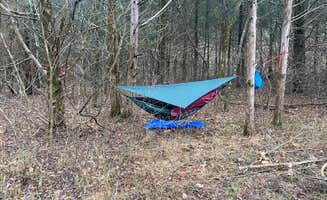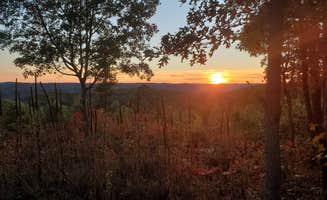Rustic camping near Stanton, Missouri centers on primitive sites within Mark Twain National Forest, which encompasses over 1.5 million acres of Ozark highland terrain. The forest features elevations ranging from 600 to 1,400 feet with numerous springs and clear streams flowing through limestone and dolomite formations. Access roads to most camping areas become increasingly rough during winter months, with freezing temperatures common from November through March.
What to do
Mountain biking on Berryman Trail: Located near Brazil Creek Camping Area, this extensive trail system offers miles of single-track riding through forested terrain. "Miles and miles of trails for Mountain Biking, horse riding or just hiking, and you can ride your ATV on the roads but you need an orange triangle," notes James D., who found this area "well worth the 20 to 30 minute trip off the highway."
Fishing in Courtois Creek: The clear waters provide opportunities for both fly fishing and cast fishing. According to Jen, "The water is amazing. Great for fly fishing and cast fishing." The creek's accessible shoreline makes it suitable for anglers of various skill levels.
Stargazing at FS-2363: The remote location offers exceptional night sky viewing conditions. Brian reports the area has "no light pollution so seeing the stars and getting some night photos is possible." Visitors regularly observe meteor showers and the Milky Way when conditions permit.
Swimming in natural waterways: Several sites offer swimming opportunities in creek waters. At Courtois Creek Dispersed camping, several families come "down with kids to swim and float," as observed by one camper. Water temperatures remain cool even in summer months, typically reaching the low 70s.
What campers like
Solitude and quiet: Most dispersed sites offer remarkable privacy. At Murphy Overlook, Kevin C. reports, "We were here two days and did not see or hear anyone." Similarly, Ryan G. states he "did not see a single car or other campers" during his stay, instead enjoying the sounds of "coyotes and lots of birds."
Wildlife encounters: The area hosts diverse wildlife viewing opportunities. Sean A. encountered "an adult black bear when we left, only about 0.5 a mile from camp" at Murphy Overlook. Birdwatching is productive throughout the region, with dawn being particularly active.
Rustic fire rings: Many sites feature established stone fire rings. At Big River Primitive Campground, Matt S. found "a beautiful setting" with "a nice fire pit with plenty of large logs for seating." Deadfall wood is generally available near most sites for campfires.
Natural water sources: Several camping areas feature access to creeks or springs. Jeremy G. describes Big River's water as "clean crisp water from the river at its origin," while noting the setting was "quiet and perfect." Water filtration remains essential at all locations.
What you should know
Vehicle requirements critical: Standard passenger cars will struggle to access most dispersed sites. At Courtois Creek Dispersed, Nicholas H. found "the road to get there isn't a road so much as a ATV trail. All wheel drive and it was too hard on my Subaru. Mostly washed out." Jason F. similarly advises Murphy Overlook "is accessible by AWD and 4x4 but I would hesitate to attempt it with any other car."
Supply planning essential: No services exist at any dispersed sites. Mike L. advises Brazil Creek visitors to "make sure you stop in Sullivan or Bourbon, MO for supplies. This site is pretty remote from any services." Nearest grocery stores and gas stations average 25-30 minutes from most camping areas.
Cell service limitations: Connectivity varies dramatically by location and carrier. Linda C. reports "No Verizon service" at Brazil Creek Camping Area, while Alexis M. confirms it's a "nice secluded area" but also lacks Verizon signal. James D. notes better options with other carriers: "The Ranger, who was very nice, had good service with AT&T, I had TMobile at my campsite with a booster."
Seasonal insect activity: Summer months bring significant insect populations. Linda C. encountered "aggressive horseflies and mosquitoes" at Brazil Creek Camping Area, along with "lots of sewer flies in the vault toilet." Bug spray containing DEET provides the most effective protection.
Tips for camping with families
Creek exploration opportunities: Children particularly enjoy wading and exploring shallow creek areas. At Courtois Creek, Jen observed "a couple families came down with kids to swim and float." Most creek access points feature gradual entries with sandy or pebbly bottoms.
Bathroom planning necessary: Nearly all dispersed sites lack toilet facilities. At Timberline Lake Dispersed, Cody S. describes a "peaceful night" in this "very off the beaten path" location, but notes no facilities exist. Families should bring portable toilet solutions or be prepared to dig catholes according to Leave No Trace principles.
Noise considerations: Some sites experience occasional traffic or nearby activity. Jen mentions at Courtois Creek, you "can hear a road and trucks passing fairly nearby. Right across the water on top of a hill is a big house that was chainsawing the next morning." Sites deeper on forest service roads generally offer better noise isolation.
Site size limitations: Most areas accommodate only small groups. Sean A. notes Murphy Overlook is "not large, this is not a multi-car big group place. I'd say 2 small car MAX." Families requiring multiple vehicles should plan accordingly or consider designated campgrounds outside the national forest.
Tips from RVers
Limited RV options: Few dispersed sites accommodate recreational vehicles. At Timberline Lake, Cody S. notes there "is a boat launch that's steep and rough" but the area can support smaller RVs. Ground clearance becomes the primary limitation rather than vehicle length.
Leveling challenges: Uneven terrain characterizes most accessible sites. At Murphy Overlook, Brian found "someone left some leveling blocks for your car as well," indicating the irregular nature of the parking areas. RVers should bring substantial leveling equipment or risk uncomfortable sleeping arrangements.
Turnaround difficulty: Many forest service roads lack adequate turning space. Kevin C. warns that at Murphy Overlook, "both [camping spots] are very small where only expert drivers can turn around a trailer." Backing long distances down narrow roads becomes necessary when proper turnarounds aren't available.



